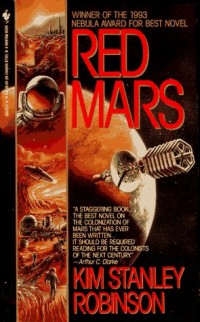
I first read Kim Stanley Robinson’s Mars trilogy not long after it first came out. Like everyone else, I was left gobsmacked not only by the multi-generational scale of the epic but also by the eerie sense that the scenario was all too plausible. It felt like we could wake up one morning and discover that it all came true.
Today, twenty years after Red Mars was first released, we know better. Forget Mars. No nation on Earth has the capacity to send a manned mission to the Moon right now and it will probably take at least a decade of serious effort to redevelop that capacity. Longevity treatment? We can’t even cure cancer and even the relatively modest Obamacare reforms is giving the U.S. huge fits.
To be fair, rereading it over the past month, I’m still struck by how detailed and complete the colonization plans are. There’s nothing wrong with the science, even if the level of technological miniaturization and modularisation seems like wishful thinking. While machines that eat Martian dirt at one end and spits out useful building materials at the other end might be theoretically possible, having it being a self-contained black box stretches credibility just a touch too far when you think about the industrial processes we use today to manufacture bricks and tiles.
But taken as a whole the step by step process of colonization never fails to fire my imagination. Reading about the early years at Underhill is always the most satisfying for me as the First Hundred unpack their gigantic machines, build the first habitats, set up the farms and the supply of water ice, get the nuclear plant started. It makes me itch to play it as a computer game.
Plus now that I’m more of an outdoors type than I was, I can appreciate all of the scenery porn a lot better. It’s pretty astounding when you think about it how much verbiage is devoted to the Martian scenery. But it’s also impressive how Robinson can read the dry facts of the Martian geography and imagine how it must when you’re there in person. Reading the description of the summit rim of Olympus Mons for example and how you can look into the caldera but not the rest of the planet from it really brought home to me how vividly Robinson must be able to picture it in his own mind.
My least favourite aspect of the novel is how cartoonish the antagonists now seem to me. Phyllis Boyle is practically a moustache-twirling villain and Helmut Bronski is a walking caricature of the pencil-pushing bureaucrat. In general, the thought processes behind the evil transnationals and the powerless UN administration are poorly characterized. Apparently it is sufficient to know that they motivated by capitalist greed. It’s a disservice to the novel that such important players in the history of Mars are written in such a simplistic way.
Finally I get that the author himself is a committed environmentalist and this novel captures the conflict between the development that is necessary for the sustenance of life and the preservation of the natural state before the advent of mankind. But I find that the author, like most environmentalists, shies away from admitting that population control is necessary to strike a balance between the two imperatives. It is hypocritical to decry the draconian birth control measures of Earth governments on the one hand, and bemoan how overpopulated the planet is on the other.
Similarly, I find myself feeling uneasy that the Martians can call for a halt to immigration from Earth because there are just too many of them while Hiroko Ai tries to make as many babies as she can and that is taken to somehow be a good thing. I guess this is why I’m not much of an environmentalist.
But as with all things, just because it’s more interesting to write about the things that you don’t like about a work of art doesn’t mean that there isn’t plenty that you like about it. The Mars trilogy remains one of my favourite science-fiction works and I look forward to slowly rereading the next two books of the series over the coming months.